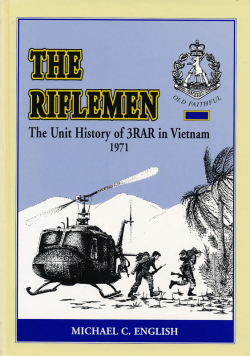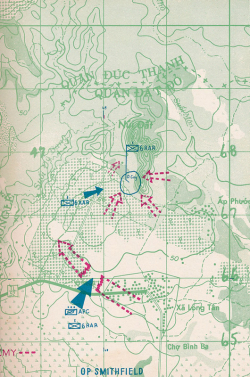The Riflemen: The Unit History of 3 Rar in Vietnam, 1971 in Vietnam, 1971

Buy online ($)
Type
Book
Authors
ISBN 10
1876439548
ISBN 13
9781876439545
Category
Vietnam
[ Browse Items ]
Publication Year
2001
Publisher
Pages
190
Description
n 1945 Australia sent three units to Japan as part of the British Commonwealth Occupation Force (BCOF). Originally known as the 65th, 66th and 67th Infantry Battalions, they were raised from Australian Divisions stationed in New Guinea at the end of the Second World War. On 23 November 1948, the battalions were renamed the First, Second and Third Battalions, The Australian Regiment, respectively. The prefix “Royal” was granted by King George VI on 31 March 1949.
3RAR was stationed at Woodside in South Australia when it was committed to the Vietnam War. It arrived in South Vietnam throughout December, 1967. Its arrival brought the 1st Australian Task Force (1ATF) up to three-battalion strength.
On 29 January, C Company was placed under the command of 7RAR for Operation Coburg (24 January – 1 March 1968). The operation was carried out on the Bien Hoa–Long Khanh border. C Company rejoined 3RAR on February 10, when the battalion relieved 7RAR. 3RAR was joined by W1 Company, Royal New Zealand Infantry Regiment (RNZIR), from 2RAR for the remainder of the operation. It returned to Nui Dat on 1 March.
3RAR next operated outside of Phuoc Tuy during Operation Toan Thang (21 April – 7 June). Toan Thang aimed to block the communist withdrawal following the Tet Offensive. 3RAR was stationed on the Bien Hoa–Bien Nuong border. On 13 May it occupied Fire Support Base Coogee, before moving 5 kilometres north on 24 May to establish Fire Support Base Balmoral. The first attack on Balmoral occurred on 26 May. A second attack took place on 28 May. In both attacks the position was mortared before a ground assault began. Both attacks were repulsed. On 5 June the battalion withdrew from Balmoral and returned to Nui Dat.
During the follow-up operation, Toan-Thang II (3–18 July), the battalion moved to the Bien Hoa–Long Khanh border. This was followed by Operation Merino (18–24 July), which took place further south in the same province. The battalion returned to Nui Dat after Merino was completed.
3RAR continued to patrol Phuoc Tuy province. It was relieved by 9RAR in November 1968. The battalion returned to Woodside, South Australia.
3RAR returned to Vietnam in 1971 and relieved 7RAR on 25 February. It was based at Nui Dat and the Horseshoe. 3RAR joined with the work of pacification. 1ATF had adopted the “Pacification Program” as its first priority in April, 1969. Pacification involved seeking out and destroying the enemy in its base areas, preventing enemy access to the civilian population and helping to create a secure climate for South Vietnamese social, political and military life to develop. This work was demanding, dangerous and monotonous for the troops. It was the primary task carried out by the battalion during its second tour.
3RAR was involved in an attack on an enemy bunker system in Long Khanh province as part of Operation Overlord (6–7 June). The bunker system was captured by the battalion, along with a second bunker system further south.
On 1 October the battalion ceased its offensive operational commitment and returned to Nui Dat. It was replaced by 9RAR. On 6 October the battalion departed Vietnam, arriving in Fremantle on 16 October.
3RAR was stationed at Woodside in South Australia when it was committed to the Vietnam War. It arrived in South Vietnam throughout December, 1967. Its arrival brought the 1st Australian Task Force (1ATF) up to three-battalion strength.
On 29 January, C Company was placed under the command of 7RAR for Operation Coburg (24 January – 1 March 1968). The operation was carried out on the Bien Hoa–Long Khanh border. C Company rejoined 3RAR on February 10, when the battalion relieved 7RAR. 3RAR was joined by W1 Company, Royal New Zealand Infantry Regiment (RNZIR), from 2RAR for the remainder of the operation. It returned to Nui Dat on 1 March.
3RAR next operated outside of Phuoc Tuy during Operation Toan Thang (21 April – 7 June). Toan Thang aimed to block the communist withdrawal following the Tet Offensive. 3RAR was stationed on the Bien Hoa–Bien Nuong border. On 13 May it occupied Fire Support Base Coogee, before moving 5 kilometres north on 24 May to establish Fire Support Base Balmoral. The first attack on Balmoral occurred on 26 May. A second attack took place on 28 May. In both attacks the position was mortared before a ground assault began. Both attacks were repulsed. On 5 June the battalion withdrew from Balmoral and returned to Nui Dat.
During the follow-up operation, Toan-Thang II (3–18 July), the battalion moved to the Bien Hoa–Long Khanh border. This was followed by Operation Merino (18–24 July), which took place further south in the same province. The battalion returned to Nui Dat after Merino was completed.
3RAR continued to patrol Phuoc Tuy province. It was relieved by 9RAR in November 1968. The battalion returned to Woodside, South Australia.
3RAR returned to Vietnam in 1971 and relieved 7RAR on 25 February. It was based at Nui Dat and the Horseshoe. 3RAR joined with the work of pacification. 1ATF had adopted the “Pacification Program” as its first priority in April, 1969. Pacification involved seeking out and destroying the enemy in its base areas, preventing enemy access to the civilian population and helping to create a secure climate for South Vietnamese social, political and military life to develop. This work was demanding, dangerous and monotonous for the troops. It was the primary task carried out by the battalion during its second tour.
3RAR was involved in an attack on an enemy bunker system in Long Khanh province as part of Operation Overlord (6–7 June). The bunker system was captured by the battalion, along with a second bunker system further south.
On 1 October the battalion ceased its offensive operational commitment and returned to Nui Dat. It was replaced by 9RAR. On 6 October the battalion departed Vietnam, arriving in Fremantle on 16 October.
Number of Copies
1
| Library | Accession No | Call No | Copy No | Edition | Location | Availability |
|---|---|---|---|---|---|---|
| Main | 143 | VT-12 | 1 | Yes |




